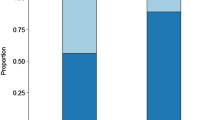Abstract
It is generally considered that information can be stored either as a procedural or as a declarative representation. A devaluation technique was used to determine whether hens have declarative representations. Individual hens (Gallus gallus domesticus) were fed in an enclosure with two containers, each with a new food type. One of the food types was devalued by pre-feeding with that food, after which the hens were tested with empty food containers. The pre-feeding should only affect the choice of the hens if they have learned where a particular food type was (declarative representation) rather than “go left when coming into the enclosure” (procedural representation). A significant proportion of the hens went to the location previously occupied by the non-devalued food (seven out of eight). This supports the hypothesis that domestic hens can form declarative representations.
Similar content being viewed by others
Author information
Authors and Affiliations
Additional information
Received: 6 March 1999 / Accepted after revision: 1 November 2000
Rights and permissions
About this article
Cite this article
Forkman, B. Domestic hens have declarative representations. Anim Cogn 3, 135–137 (2000). https://doi.org/10.1007/s100710000074
Issue Date:
DOI: https://doi.org/10.1007/s100710000074




